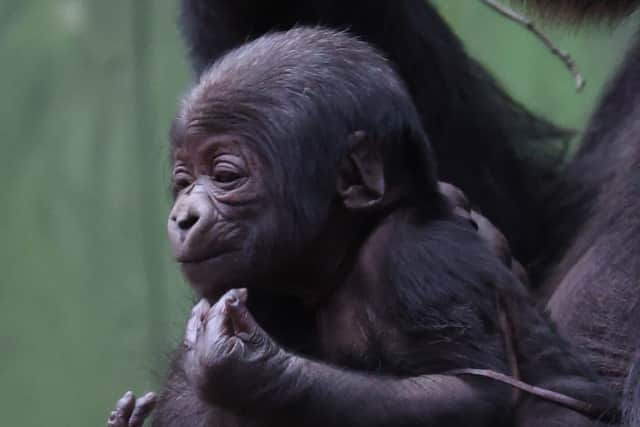London Zoo: Bumpy start for critically endangered gorilla baby - the second born in less than a month
and live on Freeview channel 276
London Zoo has welcomed a second critically endangered western lowland gorilla baby to its resident troop, after a bit of a bumpy start.
The infant, an important addition to the conservation zoo's endangered species breeding programme, was born at to mum Effie at 7:44pm last Thursday (8 February), just three and half weeks after troop member Mjukuu welcomed her baby. Effie went into labour at around 7:04pm on Thursday evening and delivered her baby in the gym area of Gorilla Kingdom. Unlike fellow-mum Mjukuu, however, zoo staff said Effie’s birth was not as straightforward - with the baby born wrapped in its umbilical cord.
Advertisement
Hide AdAdvertisement
Hide AdWhile the newborn appeared bright and healthy, London Zoo’s gorilla keepers needed to keep a constant vigil over the weekend in case the cord posed any risk to the baby. Thankfully, the team said the cord did not create any issues, and has now safely detached.


A half-sibling to the young gorilla born in January, the new arrival was also fathered by silverback Kiburi. Kiburi, 19, arrived at London Zoo from Tenerife in November 2022 as part of an international conservation breeding programme for the threatened subspecies - which aims to make sure there is a genetically diverse and healthy population.
London Zoo’s Primates Section Manager Kathryn Sanders said in a statement: “We’re over the moon to have a second gorilla infant born here at London Zoo in the space of a month – these babies are an important addition to the conservation breeding programme for this endangered species, and just as crucially, great additions to our troop.
“Effie and her baby kept us on our toes for the first 72-hours, as we wanted to make sure that the attached umbilical cord didn’t pose any risk to the newborn. It was a huge relief to see baby feeding, moving normally and to get a glimpse of its bright eyes peeking out from mum’s arms," she continued. “The two youngsters will now grow up side by side, much like their older siblings Alika and Gernot did – they’ll love having a permanent playmate."
Advertisement
Hide AdAdvertisement
Hide AdZookeepers will not be able to confirm the sex of the infant yet as it spends much-needed bonding time with its mother and family, and they will need to wait for Effie to allow them to do so. The birth of any new western lowland gorilla is a cause for celebration. The subspecies - smaller than other western gorillas - is critically endangered, and as a result of poaching and disease their numbers in the wild have declined by more than 60% over the last 25 years.
They live in dense and largely remote rainforests in Africa, making it hard for conservationists to confirm their exact numbers, but due to substantial known losses the subspecies is now categorised as critically endangered by the International Union for Conservation of Nature (IUCN).
London Zoo - as part of the Zoological Society of London (ZSL), an international conservation charity - says it is also working to protect western lowland gorilla habitats in the West Congo Basin. ZSL staff are working with local communities to help create alternative income streams for those who are otherwise reliant on the area’s natural resources, and are supporting new land-use planning to reduce the impact of deforestation – in order to protect the home of gorillas and other threatened species in the area.
Comment Guidelines
National World encourages reader discussion on our stories. User feedback, insights and back-and-forth exchanges add a rich layer of context to reporting. Please review our Community Guidelines before commenting.
